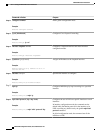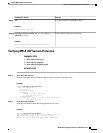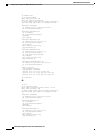
Up time: 21:09:56
LDP discovery sources:
Targeted Hello 10.0.0.5 -> 10.0.0.3, active
Addresses bound to peer LDP Ident:
10.3.104.3 10.0.0.2 10.0.0.3
Step 3
show mpls ldp neighbor detail
Issue this command to check that the MPLS LDP Session Protection state is Ready or Protecting. If the second last
line of the output shows Incomplete, the Targeted Hello Adjacency is not up yet.
Example:
Router# show mpls ldp neighbor detail
Peer LDP Ident: 10.16.16.16:0; Local LDP Ident 10.15.15.15:0
TCP connection: 10.16.16.16.11013 - 10.15.15.15.646
State: Oper; Msgs sent/rcvd: 53/51; Downstream; Last TIB rev sent 74
Up time: 00:11:32; UID: 1; Peer Id 0;
LDP discovery sources:
Targeted Hello 10.15.15.15 -> 10.16.16.16, active, passive;
holdtime: infinite, hello interval: 10000 ms
Addresses bound to peer LDP Ident:
10.0.0.2 10.16.16.16 10.101.101.101 11.0.0.1
Peer holdtime: 180000 ms; KA interval: 60000 ms; Peer state: estab
Clients: Dir Adj Client
LDP Session Protection enabled, state: Protecting
duration: infinite
Troubleshooting Tips
Use the clear mpls ldp neighbor command if you need to terminate an LDP session after a link goes
down. This is useful for situations where the link needs to be taken out of service or needs to be connected
to a different neighbor.
To enable the display of events related to MPLS LDP Session Protection, use the debug mpls ldp session
protectioncommand.
Configuration Examples for MPLS LDP Session Protection
The figure below shows a sample configuration for MPLS LDP Session Protection.
Figure 3
MPLS LDP Session Protection Example
R1
redundancy
no keepalive-enable
Troubleshooting Tips
Configuration Examples for MPLS LDP Session Protection
MPLS LDP Configuration Guide, Cisco IOS Release 12.4
36


















